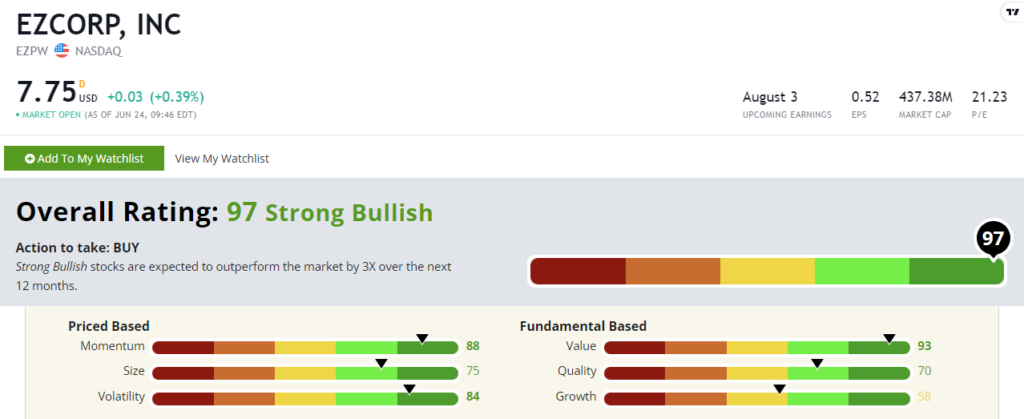Last week’s late rally was a welcome change of pace, but we’re still knee-deep in a nasty bear market.
I’m a trader, not a prognosticator. I can’t tell you when the bear market will end.
But I can help you identify profitable trades along the way and help you position your portfolio for the next bull market.
Investors have a familiarity bias. We gravitate toward stocks that we know. There’s a certain comfort in size and name recognition.
I get it. In a bear market, established large-cap stocks often hold up better than up-and-comer small-cap stocks. That impulse to stick with what you know is stronger when market conditions aren’t favorable.
Nothing Wrong With Mega- and Large-Cap Stocks
There’s nothing wrong with having a piece of your portfolio in mega-cap names, like Apple Inc. (Nasdaq: AAPL) or Microsoft Corp. (Nasdaq: MSFT). Both are fantastic companies and fine examples of what’s possible in America!
But here’s the thing.
Those companies have a harder time crushing the market over the long haul. You’re a lot more likely to find that next 10-bagger winner looking at small-cap stocks. (On that note, my colleague Michael Carr has spotted a rally in small caps. Read about it in his Chart of the Day.)
Think about it.
Buyers and sellers determine stock prices. Prices rise when there are more buyers than sellers, and prices fall when there are more sellers than buyers.
Let’s use these two massive American mega caps as an example.
Microsoft‘s market cap is just shy of $2 trillion. Apple boasts a $2.2 trillion market cap — even after the tech sell-off.
Well, a lot of buyers have to throw a lot of cash around to move the price of a $2 trillion company compared to a $2 billion company. (That second figure is considered the upper limit of a small-cap stock.)
A $2 trillion company can become a $4 trillion company, sure! Given enough time, I won’t be surprised at all if Apple or Microsoft hit that level someday.
But the bigger a company gets, the more natural it is for its growth to slow.
Furthermore, larger companies are favorable targets for government regulators looking to threaten antitrust action. Smaller companies attract less unwanted attention.
And let’s face it. Who doesn’t already own Apple or Microsoft? These companies are widely held by virtually every major broad-market mutual or exchange-traded fund.
On top of that, Wall Street analysts are always dissecting these companies. You’re not going to find an undiscovered gem by focusing on the largest companies.
Academic Research on a Stock’s Size Factor
Let’s look at this through the lens of my proprietary Stock Power Ratings system.
Size is one of six primary factors I use to analyze stocks within my system. The others are:
- Momentum.
- Volatility.
- Value.
- Growth.
- And quality.
I chose these six factors for a very specific reason: My research shows that stocks with high ratings in these factors tend to outperform over time. It’s even better when they boast high scores in more than one factor.
And apart from my own research, the academic literature is clear: Small companies outperform large companies, in aggregate, over the long run.
If you bought a portfolio of the smallest half of all stocks in the market and short sold a portfolio of the largest half of all stocks in the market at the same time … you would earn a positive return over time, thanks to the size factor.
Given the choice between two stocks with similar ratings on all other factors, we should prefer to buy the smaller one.
Unfortunately, this is a rough time to find broader small-cap opportunities.
In the same sense that it takes less buying to send a small-cap stock higher, it also takes less selling to send them lower.
I don’t recommend that you throw discretion out the window and load up on small-cap stocks just yet.
Size Factor Reveals an Opportunity
But I’m still looking.
As an example, I want to highlight a stock that topped my watchlist recently.
Pawnshop operator EZCORP Inc. (Nasdaq: EZPW) is a small-cap stock with an overall “Strong Bullish” 97 score within Stock Power Ratings.
With a market cap of a little less than half a billion, EZPW rates a solid 75 on my size factor.
We’re all struggling today with high inflation.
But that’s not such a bad thing if you run a pawnshop. When times get tough, people cut costs where they can and often resort to borrowing. EZPW’s shares have trended higher for most of 2022. It’s up around 8% for the year as I write this, and the stock got through the May and June sell-off mostly unscathed.
Meanwhile, the S&P 500, which is dominated by large-cap stocks, is down close to 20% for the year.
Bottom line: I’m not recommending you shun all large stocks for eternity. That would be ridiculous.
But for that next market-beating trade, it makes sense to focus on smaller companies.
Our Green Zone Fortunes model portfolio is loaded up with small-cap stocks, including our latest inflation-based play.
And if you want to see how we’re navigating the bear market from here, watch my “Infinite Energy” presentation for details on how to join my premium stock research service.
We have a long-term approach within Green Zone Fortunes. We’re recommending stocks in mega trends with staying power. Trends like renewable energy (the focus of my “Infinite Energy” presentation) have a long runway of growth to look forward to in the coming years and decades.
So click here and see how to join us today. Some of these small caps we’re following have incredible potential for the months and years ahead.
To good profits,

Adam O’Dell
Chief Investment Strategist





